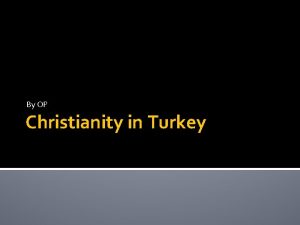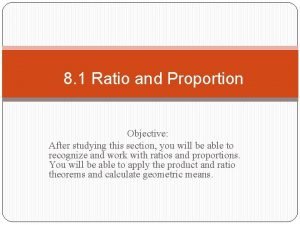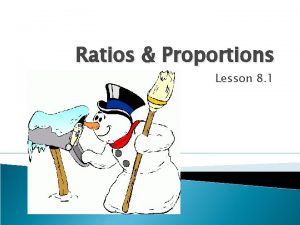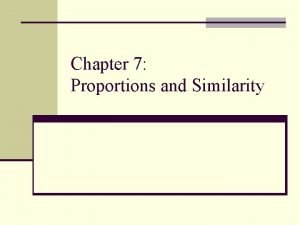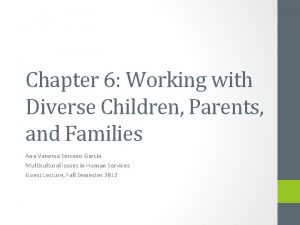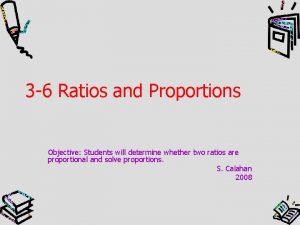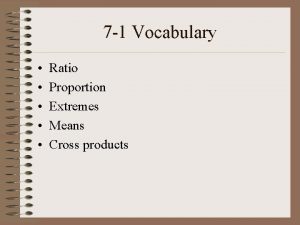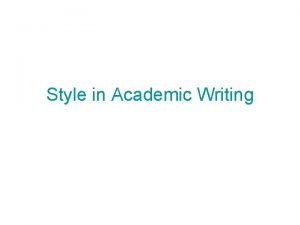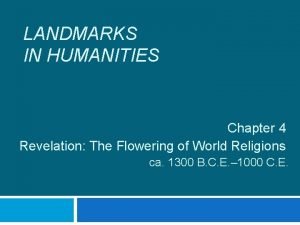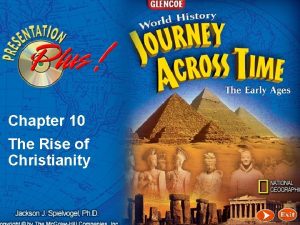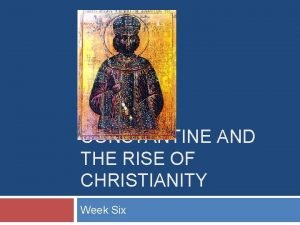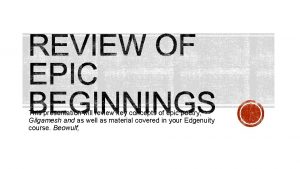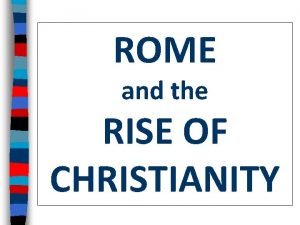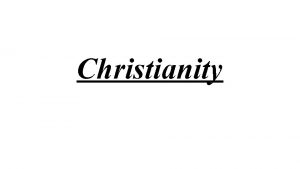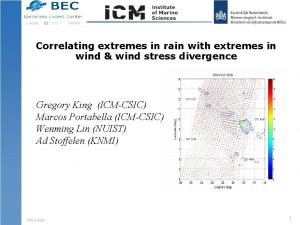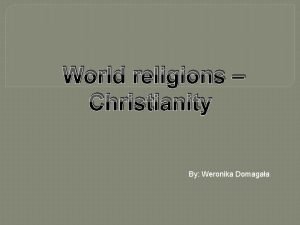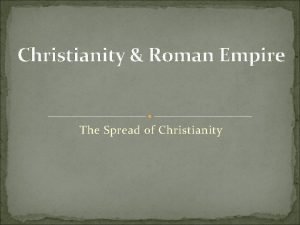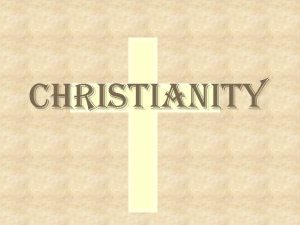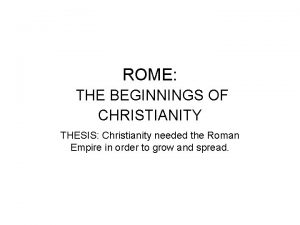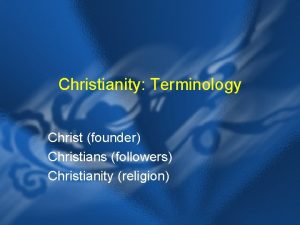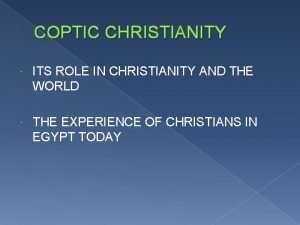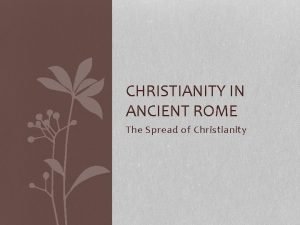A HISTORY OF CHRISTIANITY 3 1 Extremes of





















- Slides: 21

A HISTORY OF CHRISTIANITY 3. 1 Extremes of Good and Evil in the Western Church 1000 -1300 CE

THE POWER OF THE WESTERN CHURCH � � � At the end of the first millennium of Christian history, the Church in the West was at its zenith once again. Huge Cathedrals rising throughout Europe symbolised the wealth and power of the Church. The magnificence of the cathedrals reminded people that they were the house of God on earth, but also drew the eye to the heavens and a future life with God.

POPES AND PRINCES � � Two examples symbolise the ongoing struggle for supremacy between the Church and state at this time. (1) In 1077 at Canossa in Italy, Henry IV, the German Emperor, excommunicated by the Pope for trying to appoint bishops, knelt in the January snow for three days outside the Papal palace of Pope Gregory VII, seeking forgiveness. � The Pope forgave him and Henry, seven years later deposed the Pope and put in his place a much more pliable Pope in Clement III.

A FATAL COMMENT � � The second example comes from 1170 with Henry II in England, whose outburst “Will nobody rid me of this turbulent priest? ” led to the murder of his former friend, Thomas Beckett, Archbishop of Canterbury. All of Europe was horrified and Henry had to seek absolution and make restitution for Beckett’s death.

PAPAL POWER � � � In 1074 CE, in order to correct abuses in the clergy, including simony (paying for positions in the Church) and leaving church property to children, Pope Gregory outlawed simony and married clergy. The enormous suffering this caused priests, their wives and children met with considerable resistance throughout Europe. Gregory absolved people from obedience to bishops who continued to allow married priests. The struggle for power between Princes and the church in their lands continued as the Papacy in the West demanded more and more concessions for the Church.

CRUSADES: NEITHER HOLY NOR SUCCESSFUL � � Europe in the 11 th century, though Christian, was torn by incessant warring between the Lords of small kingdomes seeking to expand their power. In 1095, Pope Urban II called a Council of Peace in Clermont, France to try to end the fighting. He proposed, instead, that the warring soldiers turn their skills to rescuing Jerusalem and the Holy Land from the Muslim infidel who had captured Palestine. � He instructed priests all over Europe to preach a Holy Crusade.

THE PEASANTS’ CRUSADE � � � In 1096, 5 armies drawing on ill disciplined mobs of fighters from England, France and Germany, ill prepared and funded, marched across Europe pillaging and burning on their way to Constantinople. Led by a manic monk, Peter the Hermit, they were hated and feared. Three of the armies were destroyed when European peoples fought back. Two armies reached Constantinople and the Emperor hastily escorted them into Turkey, where they were slaughtered.

WEST DESTROYS EAST � � � In 1202, Jerusalem, captured in the slaughter of the second crusade in 1096 -99, fell again to the Muslims. Pope Innocent III called another crusade, but a Europe tired of Crusades sent far fewer knights. Manipulated by the Governor of Venice, the crusaders laid siege to Constantinople, looted and pillaged the ancient treasures and relics. They were excommunicated by Innocent III, but he used the crushing of the Eastern church to further spread the claims of Papal supremacy over the whole church. Constantinople was occupied for 60 years and by its end, the schism between the church of the East and West was complete.

THE COST OF THE CRUSADES � Politically, a benefit of the Crusades for Europe was the expansion of trade and knowledge and commerce. � For the Church, there was great wealth, but overall, religiously, the Crusades were one of the darkest periods of Church history. � There were nine crusades in all, from 1095 to 1272. There was nothing Christian about them and they were hated by peoples all across Europe and the Middle East. They generated an antagonism against Christianity that survives to present times.

REFORMERS: SAINTS OR HERETICS � Not everyone approved of the amassing of power and wealth in the Church. Outspoken leaders arose in the church calling for reform and a return to true religion. � But the social structure of Europe considered unity and order and stable power relationships between church and state as God’s desire for humanity. � Reformers were therefore a source of discomfort and possible instability, and so their success and acceptance depended on their support by the state and the church.

REFORMERS ACCEPTED BY THE CHURCH � St Bernard of Clairvaux (1090 -1153). Turned his back on the wealth of his world. Chose a life of self-denial and prayer. In 1115, he founded the new House of Clairvaux with a dozen Cistercian monks. Considered the most influential Christian of his age. � St Dominic (1170 - 1221). Belonged to a strict Benedictine chapter at Osma. Preached against the Albigensian heresy. Founded an order of preachers in 1216 to convert peoples, rather than conversion by the sword.

“ACCEPTABLE” REFORMERS � Francis of Assisi (1182 -1226). Born into a wealthy family, he left home and possessions to embrace literal poverty to become a mendicant preacher. Founded the “Lesser brothers” in 1210. The poor and the sick were his particular focus, as was a life of poverty and communion with nature. � Clare of Assisi(1194 -1253). Inspired by Francis, she founded a monastic order of nuns called the “Poor ladies” and wrote their rule of life- the first known to be written by a woman.

“ACCEPTABLE” REFORMERS � Thomas Aquinas (1225 -1274). Considered the greatest scholastic theologian of the Middle Ages. Influenced by Aristotle. Wrote two great works: Summa Theologica and Summa Contra Gentiles. � Catherine of Siena (1347 -1380). She experienced visions of Christ and sought a monastic life, but felt called to serve Christ in the poor in the world. She dictated letters to influential people, including Popes and attempted to convince the Avignon popes to return to Rome during the Western Schism.

HERETICS: UNACCEPTABLE REFORMERS � About six years before Francis of Assisi was born, (1175 -6) a wealthy merchant in Lyons called Peter Waldo was converted to Christ and gave away all he had to live a simple life of poverty. Others followed his example, going about two by two, preaching and exalting poverty. The Archbishop of Lyons prohibited his preaching, but they were even more zealous. Waldo was excommunicated in 1185. By the end of the 13 th century, Waldensians were all over Europe and widely persecuted.

THE ALBIGENSIANS (CATHARS) � This group, from Languedoc in France, believed in two Gods, one a pure Spirit, whom they worshipped and one corporial, chaotic and worldly. Influenced by gnosticism, they grew to a mass movement. Pope Innocent III tried to convince them or the error of their ways by sending the Dominicans, but then reverted to a crusade against them when that failed. It finally took the horror of the Inquisition to end them.

AN ENGLISH HERETIC � John Wycliffe (1329 -1384). A philosopher at Oxford University, his views on reforming the Church and the Eucharist were condemned by the Pope in 1377. He translated the Bible into English (Wyclif Bible). His loyal followers were known as Lollards, a derogatory term for uneducated people or those educated on in English. He was declared a heretic posthumously in 1415 and his body was removed from holy ground in 1427.

BURNED AT THE STAKE � John Huss (1374 -1415) was ordained a priest in 1401. Influenced by Wycliffe, he proclaimed only Christ was head of the Church. His statements against the authority and on the corruption of popes and cardinals led to his burning at the stake. The Czech people rose in his support and the Hussite church was formed in Bohemia. Luther was influenced by his arguments.

DEALING WITH OPPOSITION � The Church’s usual response to challenges to its authority, rights or teachings usually involved: � Condemnation by Bishops or Rome � Attempts at convincing a change of heart or reconciliation through use of emissaries, preachers, or the influence of other secular leaders � Threats of interdict and excommunication of individuals and whole countries � Banishment from civilised society- e. g. Jews, Muslims � Trial by persecution for individuals, or military offensives for groups or countries � Death by burning or decapitation or strangling

THE POWER OF EXCOMMUNICATION � � � One of the most powerful weapons in the Papacy’s arsenal was the threat of excommunication and the placing of entire countries under interdict. Excommunication for an individual meant denial of access to a church, priest, the sacraments and blessed ground for burial. It meant condemnation to hell. Anyone assisting them was also excommunicated. The Church literally claimed to have control over a person’s eternal salvation. Interdict was the banning of all religious services and sacraments, except for the dying, in a country or state. The innocent were denied access to the church (sometimes for years) as a means of pressuring those out of favour- usually politically rather than religiously- with the Papacy. At one time or another, most countries in Europe had been under interdict (some several times) and many kings and princes had suffered (or been threatened with) excommunication at one stage or another. The Patriarch of Constantinople, Nicholas Mysticus, even excommunicated the Emperor Leo VI in 906 because of his fourth marriage.

INQUISITION After Pope Innocent III’s crusades against heretics failed in the 12 th century, Pope Gregory IX in 1231 instituted Courts of the Clergy- The Holy Inquisition. � Left unchecked by secular leaders, the Inquisition used torture and death on people all over Europe accused of infidelity or Heresy. � Perhaps its worst expression was the Spanish Inquisition instituted by Ferdinand Isabella in order to unite Spain and force one faith on the newly united states. Jews and Muslims were banished or put to the trial. � The Inquisition is perhaps matched only by the Crusades as the worst aberration among many of Catholic Christianity. The Congregation for the Doctrine of the faith is its modern day successor. �

AVIGNON OR ROME? � � The Avignon Papacy was the period from 1309 to 1378 during which seven Popes resided in Avignon, in modern-day France. [1] This arose from the conflict between the Papacy and the French crown. During its time in Avignon the Papacy adopted many features of the Royal court: the life-style of its cardinals was more reminiscent of princes than clerics; more and more French cardinals, often relatives of the ruling pope, took key positions. In 1378 the seat was moved back to Rome, while a disputing party continued to honour the bishop in Avignon as the head of the church. From 1378 to 1414 was a time of difficulty which Catholic scholars refer to as the "Papal or Western Schism“. The Council of Constance, which convened in 1414, finally resolved the controversy, dismantling the last vestiges of the Avignon Papacy and brought the Great Schism to an end in 1417.
 History of christianity in turkey
History of christianity in turkey Ratio and proportion for use after section 7-2
Ratio and proportion for use after section 7-2 Means and extremes examples
Means and extremes examples Equal ratio theorem
Equal ratio theorem Means and extremes examples
Means and extremes examples Means and extremes
Means and extremes Lewis terman ap psychology definition
Lewis terman ap psychology definition Bicultural couples tend to demonstrate extremes in
Bicultural couples tend to demonstrate extremes in Means and extremes
Means and extremes Means-extremes property of proportion
Means-extremes property of proportion Extremes of a proportion
Extremes of a proportion Box and whisker plot worksheet doc
Box and whisker plot worksheet doc Avoid extremes
Avoid extremes One landmark of early buddhist culture is the
One landmark of early buddhist culture is the Triple venn diagram of judaism christianity and islam
Triple venn diagram of judaism christianity and islam Theravada buddhism beliefs
Theravada buddhism beliefs Chapter 10 the rise of christianity
Chapter 10 the rise of christianity Loki's father norse mythology
Loki's father norse mythology Constantine rise of christianity
Constantine rise of christianity Christianity main ideas
Christianity main ideas Christianity vs paganism chart
Christianity vs paganism chart Christianity
Christianity
